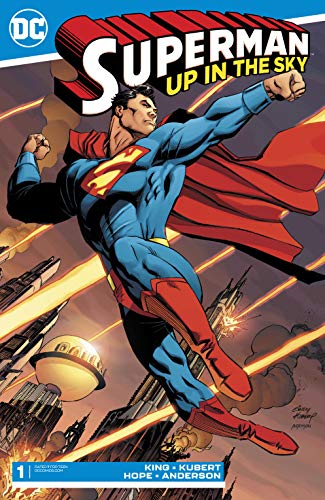‘Superman: Up in the Sky’ Points Towards Hero’s Roots
Modern comic writers often face a challenge when writing for Superman: how to give Superman enemies who are real threats. After all, Superman may seem so overwhelmingly powerful that he needs an opponent who is equal to him or near enough to be a real threat.
However, writer Tom King doesn’t take that approach in his mini-series Superman: Up in the Sky.
King brings a unique perspective to the world of comics. His writing career began after joining the CIA as a counter-terrorism expert after the Sept. 11, 2001 terrorist attacks. His work is often dark and cynical. In the pages of Batman, he spent a year teasing and preparing for the caped crusader’s wedding to the Catwoman, only to leave Bruce jilted at the altar at the end of the highly marketed Batman #50. He also wrote the controversial Heroes in Crisis, a miniseries that attempted to raise mental health issues by afflicting superheroes with mental illnesses, but left many fans angry for having “ruined” various characters.
However, in Superman: Up in the Sky, we’re treated to a warm, mostly positive take on the Man of Steel.
When Superman stooped to help the weakest
Readers often compare Superman to Christ. Of course, the hero was created as a Moses-figure by two Jewish kids from Cleveland. Yet most modern writers treat him like a Greek god, primarily known for his exploits against powerful monsters that will consume us all. Yet in the beginning, Superman was just as concerned for individuals and smaller problems. In Superman’s earliest comic strip and newspaper adventures, he was not just involved in epic battles against villains. He would also care about regular people in their problems. Superman used his great power to help an orphan trapped in an abusive orphanage, to give a second chance to a boxer, and to help the father of a veteran suffering from PTSD understand that his son was no coward.
In one 1940 newspaper strip story, a letter arrives at the Daily Planet. It came from “the meekest man in the world,” who was constantly picked on and whose life was failing. Lois Lane laughed at the letter writer and considered him pathetic. But Superman took up this mission, declaring, “This fellow and his problem may seem petty, but to him it’s the greatest crisis in the world!” And so Superman spent months (by newspaper strip time) helping this man straighten out his personal and professional life.
Since then, this vision of a Superman touching individual lives has become far less prominent. One of the more recent exceptions is J. Michael Straczynski’s Superman: Grounded storyline, which has Superman returning from Earth after events in deep space and walking across America to connect with and help ordinary people. However, Superman: Up in the Sky takes it to a whole other level.
A super-search for a lost soul
In Superman: Up in the Sky, a foster child is kidnapped is kidnapped from Gotham City. Evidence indicates she was taken into outer space. Superman advises the Green Lantern Corps to watch for her. But in a big universe, she’s like a needle in the haystack. Her only realistic hope is if Superman dedicates himself to search for her. Thus, Superman leaves Earth in search of the kidnapped girl.
Originally this story was serialized in ten– to twelve-page chunks over the course of the year, in the 100-page comics sold at Walmart. That’s why King doesn’t tell this story as a coherent narrative, moving from start to finish. Rather, Superman: Up in the Sky unfolds vignettes that explore Superman over the course of this quest.
Stories are full of beautiful artistic splash pages by artist Andy Kubert, an tons of text boxes share the character’s thoughts.
In one installment, Superman must engage in a brutal boxing match to continue with his journey.
In another, Superman worries about Lois and fears she will die because he’s not around to save her.
In yet another installment, readers are reminded that King was a philosophy major. Superman is split into two parts: man and Superman.
In another, Superman is tempted by an idyllic life to stop his quest.
In another story, Superman’s dialogue becomes a strange poem where he addresses the villain as “sir” and each line is a contradiction of the villain. (such as, “No, sir, I do not”). This story shares more than a few dark turns, including the revelation that this kidnapped girl has been bounced from foster home to foster home and that she has suffered abuse.
Despite the darkness, or because of it, this may be one of the stories where Superman best reflects Christ and the heart of our spiritual hunger. The book asks this key question: “Is it worth leaving the world to save one lost, abused, cast-off child?” Many characters debate this question, but Superman is emphatic that he will. Many challenge the logic of the decision, but friends and foes alike know what Superman will do because it’s in his nature. Superman will journey, and even undergo physical and emotional suffering, as he reaches out to save her despite the great cost he must pay.
Many readers doubtlessly love this approach. (Apparently so does Tom King, judging by his attempts to address these longings.) Some readers, however, will dismiss this positivity as something only found in the pages of jumbo comics from Walmart or Trade Paperbacks. Still, I think Superman: Up in the Sky works because it shares beautiful common grace, which points to the deepest longings and desires of the human heart.
King’s style is not for everyone. But if you want a mainstream superhero comic, with unusual storytelling and emotional depth, Superman: Up in the Sky is worth checking out.







































I think the real challenge of Superman is making him interesting in the first place.